#Shirakawa park
Video
20231229 Osu-Shirakawa-Sakae 8 by Bong Grit
Via Flickr:
白川公園の遊具。紺色のイモムシにしか見えない。 @Shiwrakawa area, Naka ward, Nagoya city, Aichi pref., Japan.(愛知県名古屋市中区 白川公園)
#Dark blue caterpillar#Catepiller#Playground equipment#Playground#Park#Shirakawa park#Street#Candid#Snap#Shirakawa#Shirakawa area#Naka ward#Nagoya#Aichi#Japan#Nikon#Nikon Df#AF-S NIKKOR 50mm f/1.8G (Special Edition)#flickr
3 notes
·
View notes
Text
Navigating Nagoya: Must-see sights in and around Japan's historic city
Nagoya, Japan’s fourth-largest city, often remains overshadowed by the glamour of Tokyo, the cultural richness of Kyoto, and the hustle and bustle of Osaka. Yet, Nagoya is definitely a hidden gem, a vibrant city waiting to be explored.
Here, history mingles seamlessly with modernity, offering a unique travel experience which I discovered when I joined the international trip qualifiers of Sun…

View On WordPress
#NavigatingNagoya#Atsuta Shrine#comfortable footwear#Hori River#immersive travel#japan#Macaulay Club#Nabana No Sato#Nagoya#Nagoya attractions#Nagoya Castle#Nagoya clothing#Nagoya history#Nagoya modern architecture#Nagoya navigation#Nagoya travel#Nagoya weather#Osu Kannon Temple#practical travel tips#Shirakawa Park#Shirakawago Village#sun life philippines#sun talks digital media edition#Takayama Old Town#Tokugawaen Park#travel essentials
1 note
·
View note
Text
Class A field trip around Japan - Day 3
See Day 1 for context. (Translations are google translate / stuff I found translated (credit). Apologies for any errors, feel free to suggest corrections).
EDIT: In the meantime I saw someone already made translations / posted all of this. Here is their post with translations (can't reblog it, as I think I'm blocked by them)

Aizawa: Bakugou, you are too loud!
Deku analyzing "sauce katsudon" from Fukui with Ochako and Mineta

🥦: mutter-mutter-mutter: It's a sour sauce that originated in Fukui Prefecture. The sauce soaks into the cutlet and creates a deep flavor!!! You can say that the sauce is helping the katsu, but also that the katsu is helping the sauce Exactly like the food embodiment of "tasukete katsu, katsutte tasukeru" (save to win, win to save). [Yes, there's one tsu too much, so it's another katsu (food) but also like katsu (win)]. You could even call it the soul food of a hero. I don't think it's an exaggeration. ..This is a food that embodies the idea that cutlets can save people. I won't stop...I want all of Japan to know this..
🍇: 😵
🍵: He's saying that it's delicious...
The sweet tooth brigade (Sato, Momo, Ochako, Shoto) trying out Aichi's Ogura toast:

🍬: I've been waiting... This is...
🍑: Yes, it's delicious
🍰: Half-sweet, half-salty...
Jirou, Ojirou and Hagakure at the Jigokudani Monkey Park which is famous for its Japanese macaques soaking in hot springs.

🤲: Ojiro-kun! I can't really see it (his tail)!?
👂: We are being watched!
🐿️: Because I have a tail, they are conscious of their territory... (???)
(Not sure, it seems to be a tail-joke)
Mina, Asui, Todoroki and Kouda visiting the Sado island - Rabbit Kannon

👽: Justice!!! So cute!
🍰: Is “justice” cute? Well then. This Kannon is auspicious for the heroes.
🐸"Cute" is also very deep.
(I don't fully get this one, but I think the joke is that Todoroki is confused by Mina's use of slang).
Sero, Kaminari, Mineta, Mirio at the fruit trees of Yamanashi overlooking Mt Fuji

(I can't make sense of the dialogue here - sg. about Mirio being a tourism ambassador?)
Iida, Deku, Bakugou, Kirishima and All Might at Omicho market in Ishikawa prefecture

👓: There are over 180 stands here!!
💥: Just tell me which one is the most delicious!!
🥦: Well, that would be every single one
🦈: Ugh~ one day is not enough
AM: The boys look like they're having fun
Todoroki and Tokoyami at the Kurobe Dam (the biggest dam in Japan)

🐦⬛: A Torrent of Power, Liberation from Commandments. Those who were once sealed together, have released their powers. Can you feel it, Todoroki!
🍰: Not especially.
Deku, Iida, Ochako and Sero at Shirakawa Gassho-zukuri village - (Uraraka's quirk pose is similar to the roofs)
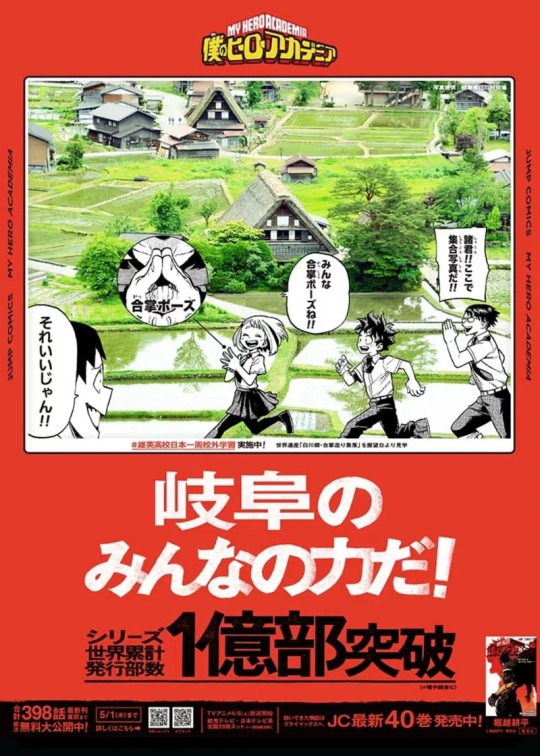
👓: Let's do a photo!
🍵: Grassho pose!
🧻: Good one!
Momo, Mina, Aoyama and Shoji at Mt Fuji - As seen from Shizuoka's tea fields

✨: Blue mountains are beautiful, aren't they?
🍑: Mt. Fuji must be seen from a distance to see its full size, which is why it looks blue. The light scatters the blue light, creating a thick layer of air between them.
👽: Yaomomo, you know everything!!!
👉Day 1
👉Day 2
#class a field trip#class a field trip around Japan#100 million tour#class a#bnha#bnha official promo#midoriya izuku#ochako uraraka#todoroki shouto#tokoyami fumikage#ashido mina#yaoyorozou momo#many others
19 notes
·
View notes
Text
🎡 DAIYA NO ACE & READER: AMUSEMENT PARK EDITION !
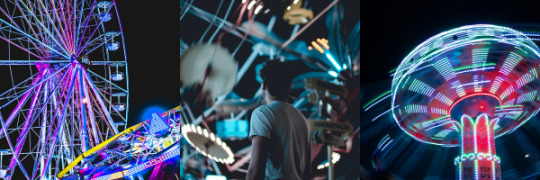
you're going to your local carnival together - so what sort of activities will your date be filled with?


R O L L E R C O A S T E R S
these adventurous boys are all about thrill and excitement (even if it may not show outwardly for some of them at first!), and you can't help but get caught up in it. whether you're screaming your lungs out or perfectly calm on a roller coaster, he'll be holding your hand the entire time. when they show your pictures at the end, he'll get a copy and keep it as his wallpaper before he finds another fun ride for you to take on together.
➤ umemiya seiichi, kuramochi yoichi, isashiki jun, shirasu kenjiro

C A R N I V A L G A M E S
guess who'll be that one person carrying around a pile of giant stuffed animals all over the park? that's right - you (of course, he'll offer to carry them all once he's done winning all the games). he's determined to show off in front of you despite the fact that the games are rigged, and whether or not he's a pitcher, you bet he'll want to try knocking down those milk bottles. he'll spoil you with all the cotton candy and treats you want as you take in the bright lights and excitement of the crowd with him by your side.
➤ narumiya mei, furuya satoru, yuki tetsuya, maki yosuke

F E R R I S W H E E L
what's better than a scenic view with your date? a view high up in the air, of course - this classic romantic ride won't get your heart racing from adrenaline, but from the intimacy of being so close with your carnival date. he'll hold your hand and point things out with the other - the setting sun and stars twinkling into view; the neon lights of the stalls below; the way the fireflies flicker in the shadows of trees. he watches you as you stare in awe at the sights, leaning forward slightly and mouth agape. and cliché as it is, he can't see anything out there more beautiful than you.
➤ shirakawa katsuyuki, kominato haruichi, kawakami norifumi, takigawa chris yu, matsubara nao

B O U N C Y C A S T L E
your date knows how to have fun and live life to the fullest. a bouncy castle is the perfect excuse to tease you - when you fall, he'll keep jumping higher as your lungs fill with laughter and he eventually helps you up, promising to hold you and not let you fall again. any inflatable ride? you're on that - zipping down the giant slide holding hands, racing each other on the obstacle course - touchy as a pair of young lovers who can't keep their hands off each other. you'll cool off with some colourful slushies or soda floats, and he'll get you the cutest little balloon animal to top off such a perfect day.
➤ todoroki raichi, hideaki tojo, nagao akira, sawamura eijun, kanemaru shinji
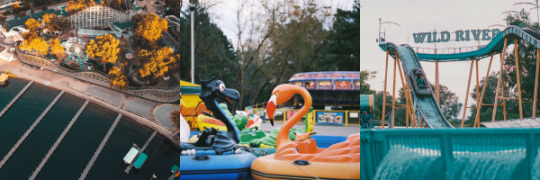
W A T E R R I D E S
your date is a bit more unpredictable - what's next? the splashing log ride? the tunnel of love? a paddleboat or lazy river? there's something about being by the water with you that he can't resist. first, something cooperative - you'll be paddling together, maybe some friendly bickering depending on the guy, but you're sure to have a lot of laughs along the way. next, something to get your adrenaline up - the log flume where you both get soaked and sit a bit in the sun to dry off. and last, an easygoing boat ride, where he looks deeply into your eyes and tells you what an amazing time he's had with you.
➤ kamiya carlos toshiki, amahisa kosei, miyuki kazuya, okumura koshu, masamune hongo

B U M P E R C A R S
get ready for a bit of friendly competition with this one - he'll be the one that rams into you every chance he gets, but absolutely terrorize anyone else who thinks they can bump into you. you'll have fun spinning around and trying to catch him by surprise, but he's always looking for you among the loud screams and chaotic cars. when the ride powers down, he's there right away, helping you out and catching you when you trip and lean a little too far into his chest. while waiting in line, he'll make playful bets like who most people are gonna target that round, and he might even sneak in a quick kiss on your cheek before you get in the car...
➤ sanada shunpei, watanabe hisashi, kominato ryosuke, yuki masashi, harada masatoshi

hi friends, hope you enjoyed this one! let me know what you'd be doing and with which character! once again, let me know if i missed anyone that you wanna see... though i added a few more. this is a bit of a short one, but just tryna warm up my writing again!
all images from unsplash, dividers from saradika
#💭-ani-mini#⚾️-dna#diamond no ace#amusement park#daiya x reader#daiya imagines#yes i hc that shirasu loves roller coasters. idk why
22 notes
·
View notes
Text
The Shirakawa Yoshimi Shrine
I already got my preamble over in my last post, so there's no need for one here, let's get right into it!
Right after the visiting the Kamishikimi Kumanoimasu Shrine, we went to the nearby Shirakawa Spring (白川水源 lit. "white river water source").
So here's the shrine within the grounds of which the spring is found, the Shirakawa Yoshimi Shrine (白川吉見神社), located on the souther foot of Mount Aso.
Below: The entrance of the shrine, as marked by the two komainu statues and the shimenawa bound torii gate. From this website on the shrines of Kyushu.
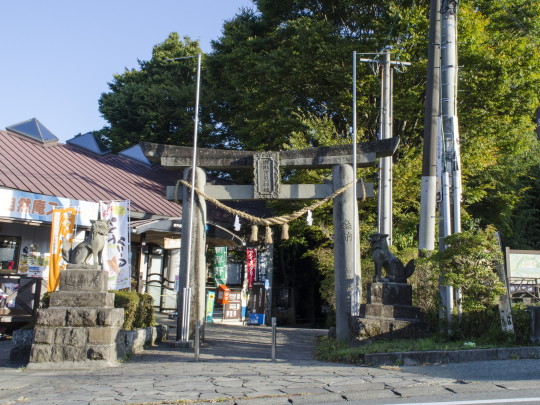
My visit to the shrine
Like I mentioned, we headed here right after leaving the Kamishikimi Kumanoimasu Shrine from my last post.
Unlike that shrine, this one's rather more famous (or rather, its spring is famous), and so has a car park located conveniently next to the shrine's entrance, as well as a gift shop selling local goods and souvenirs.
Below: My own image of the shrine's entrance.

As you could see, I only caught the un-shaped komainu statue, i.e. the one with its mouth closed, this was cause stand any further back and I'd be out on the car road. So instead:

Here's another one with the a-shaped komainu, i.e. the one with its mouth open. Together, they are said to form "Aum" (or perhaps more commonly "Om"), a sacred syllable in many religions, Buddhism included.
Anyways, we passed through the gate, we walked along the shrine road, which had a few souvenir shops and little rest houses as well, and even this little stall!

"Everything is 100 yen!!" It's an unmanned shop probably where local farmers leave their excess crops to sell, here we see bags of potatoes and eggplants.
Passing the shops and stands we move into an area where the trees part, coming face to face with a river. This is of course the eponymous Shirakawa (白川), "the white river".
Below: A section of Shirakawa I saw on the way to the spring.

Finally, we arrive at the shrine proper, passing by a toll gate. The shrine's been getting more and more visitors due to its fame, and so started collecting a modest fee of 100 yen per visitor (of high school age and above) for environmental conservation.
Before passing the second torii gate and going to the shrine building, we find a lowered platform that allows visitors to get near the river.
Below: The lowered area.
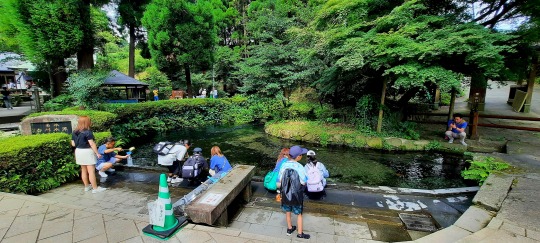
The tray on the left of the wooden bench has various funnels and ladles, allowing visitors to get their own bottle of pristine Shirakawa spring water. I myself took a sip of the water, and it was refreshing indeed~.
Notably, the river itself also serves as where visitors cleanse themselves before paying respects at the shrine. Shinto deities abhor defilement and impurities, thus it is customary to cleanse oneself, typically with water.
A good number of shrines have a fountain, called a chouzu-ya (手水舎 lit. "hand water pavilion"), where one is expected to wash their hands and mouth, to purify themself before meeting the shrine's god.
However, this shrine simply uses the natural spring water that flows from within shrine grounds. After all, why use the man-made when we have access to the gods' blessings directly?
(Do note though to be careful not to let water spill back into the river, and definitely do not spit water that's used to cleanse your mouth back into the river. The floor around will do.)
Below: The entrance of the shrine proper, pass the shrine road, from the same site previously mentioned.

Having cleansed myself, we go through the shrine's second torii gate and towards the shrine buildings. The engaku (on both gates actually) reads, plain and simple, "Shirakawa Yoshimi Shrine".
Below: The second torii of the shrine, pass it is the shrine proper.
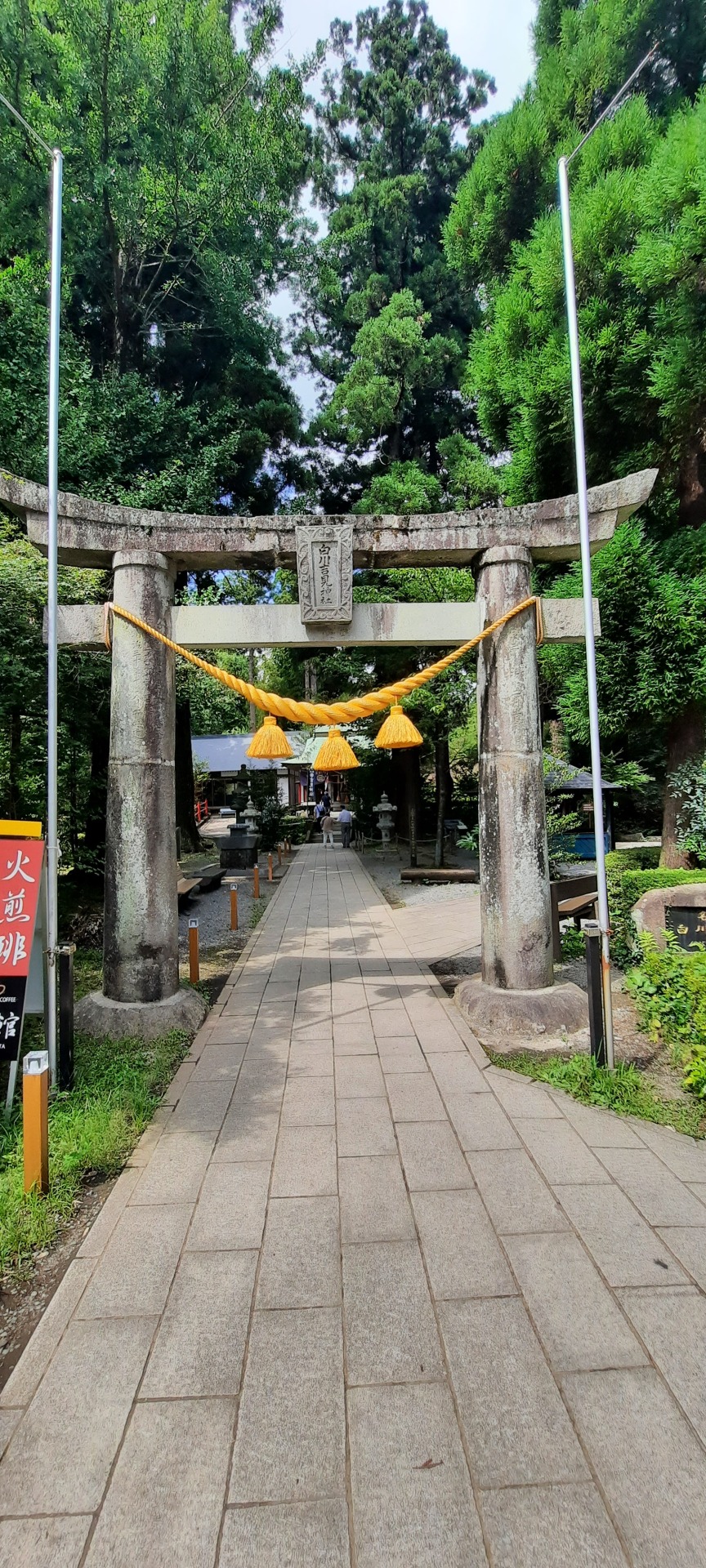
Right after we enter, on the left is a typical man-made chouzu-ya fountain, on which reads "seishin" (清心), "to purify one's heart" or simply "pure heart, which is how one should conduct themself before the gods.
Below: The shrine's proper chouzubachi, taken from the same site once again.

Of course, as you see from the image, it doesn't even have a ladle for you to get water from it. They really do expect visitors to cleanse themselves with the river, after all.
As you can see from the image of the torii gate, the road branches into two. We went on the right path first, which leads to the shrine's greatest treasure: The Shirakawa Spring.
However, before reaching the spring, we come across a small hokora (祠), a small-scale shrine where local folk deities are often enshrined. This particular one enshrines Suijin (水神 lit. "water god") the god of the spring.
Below: The roadside hokora.
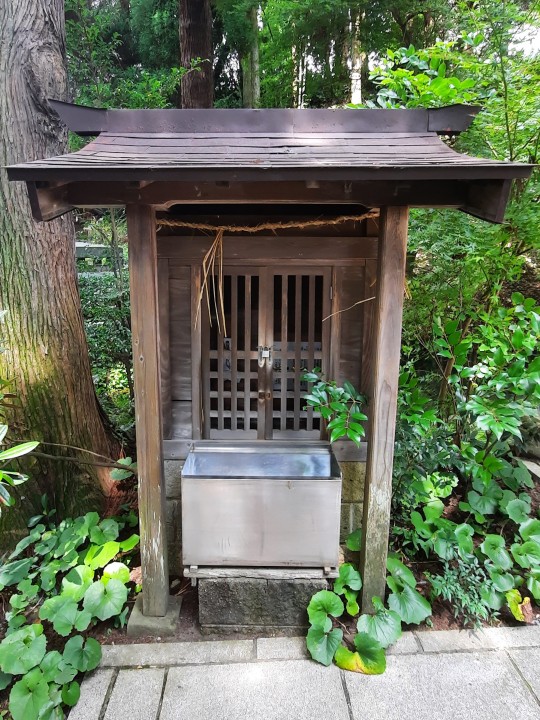
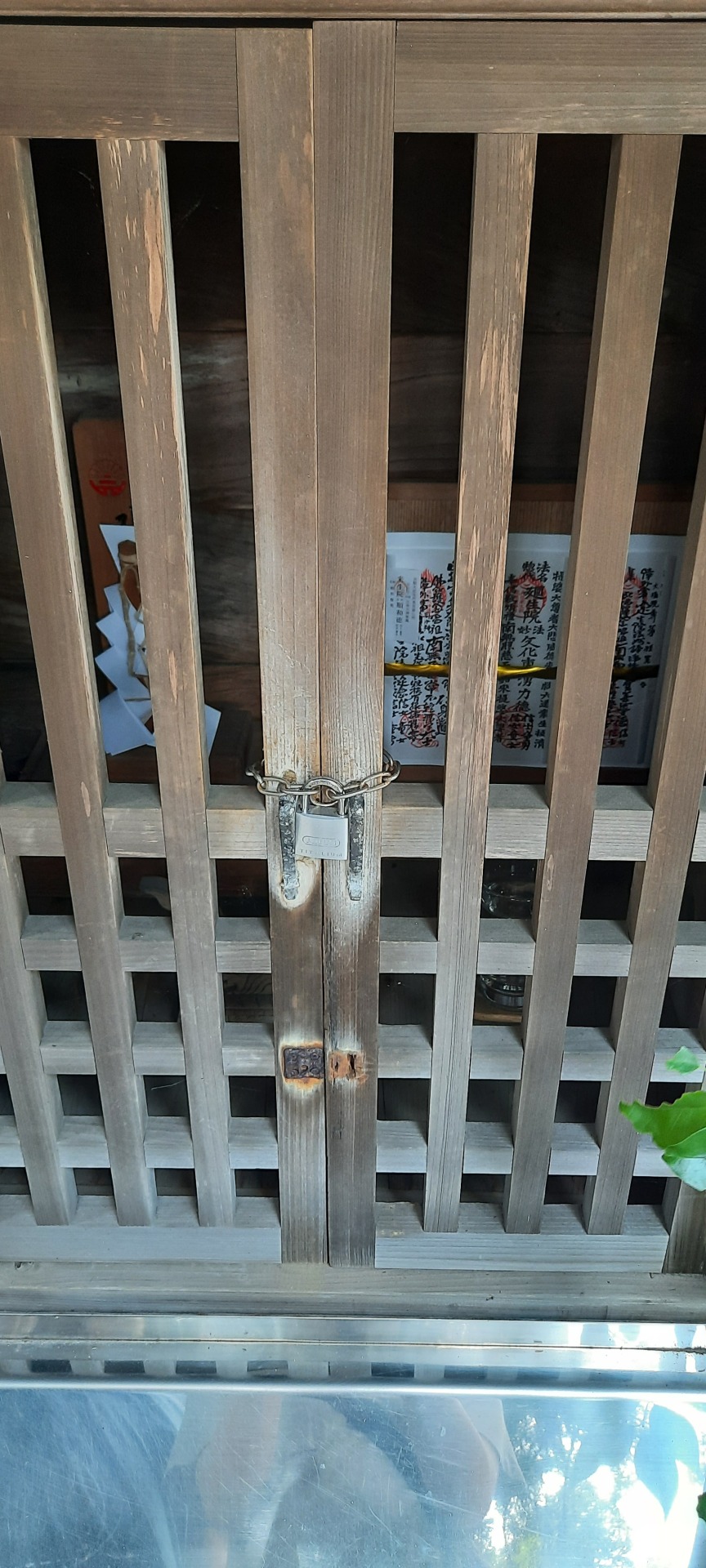
Anyways, passing the hokora by we reach the spring itself!
Below: The Shirakawa Spring.

The spot in the middle that's especially blue is where the water was gushing out from, and oh how clear the water was! And look at the moss growing on the river bed! It really was an awe-inspiring sight~.
Here's a video, which hopefully shows off how water gushes out from the riverbed (don't mind the cicadas lol it was prime cicada season).
After marvelling at the spring, I took a quick look the shrine buildings. Starting with: The prayer hall. The flags being displayed out front read "Yoshimi Shrine" (吉見神社).
Below: The prayer hall.
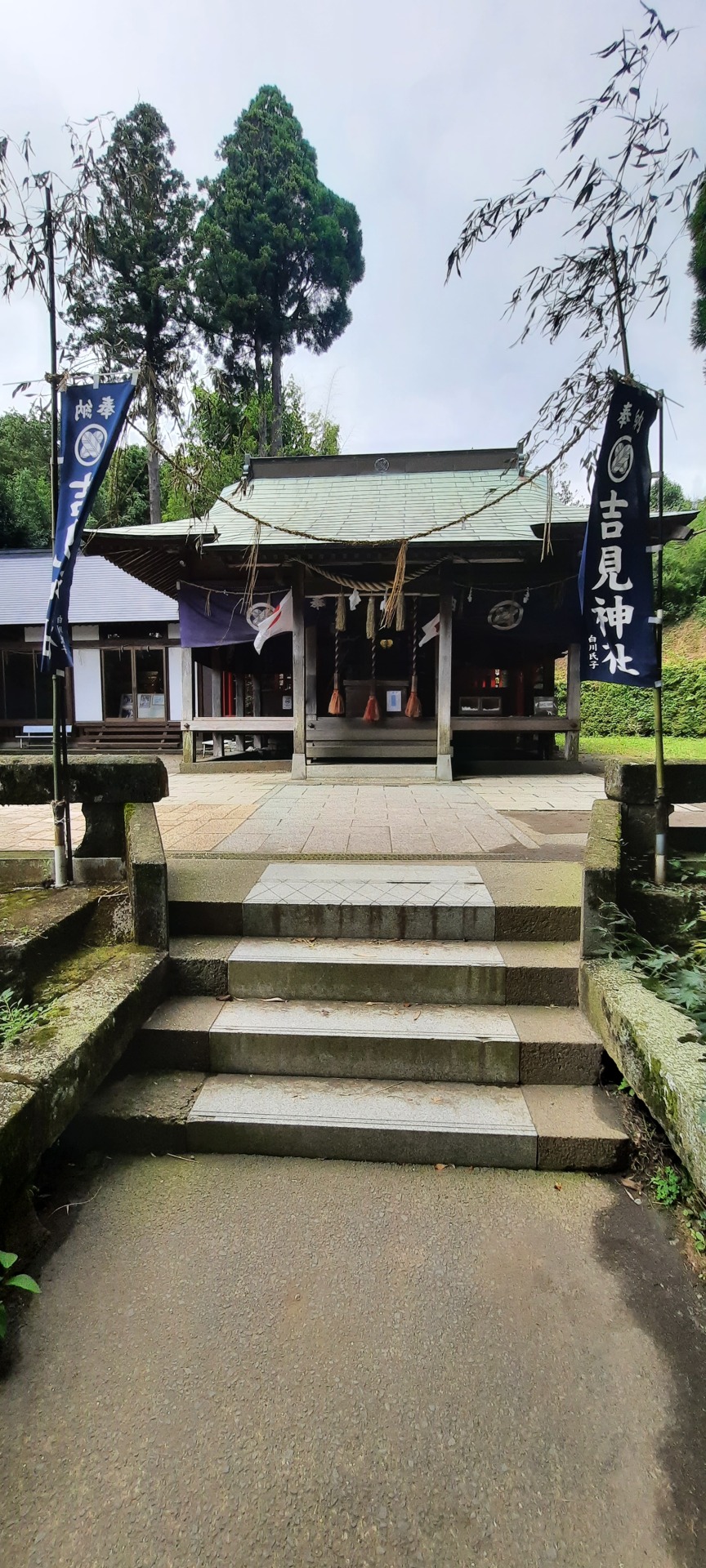
The white building to the left of the shrine is the shrine's mikoshi storehouse, mikoshi (神輿) being divine palanquins in which the gods' spirits are housed during festival parades.
Below: A glimpse of the palanquins as seen from outside.

Next, I went to the right of the prayer hall, and took the following side-shot of the shrine building. Here we can get a glimpse of its main hall too, where the gods are housed.
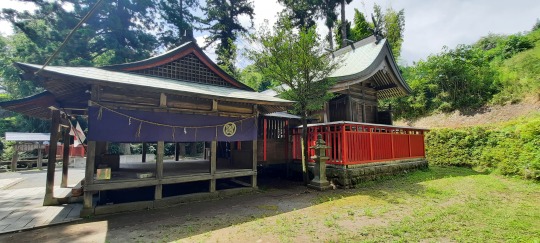
Opposite the main hall, on the right, is a smaller subsidiary shrine also under the management of the Shirakawa Yoshimi Shrine.
This one is simply classified as a keidai-sha (境内社 lit. "shrine within [shrine] grounds"). It used to be that these subsidiary shrines are divided into two types:
Sessha (摂社), colloquially called "auxiliary shrines", where gods related to the main shrine's gods are enshrined; and
Massha (末社), "undershrines", where unrelated gods are enshrined.
It used to be that auxiliary shrines are at a higher rank than undershrines, but this class system has now been discarded, any some shrines no longer list out which these subsidiary shrines used to be. This is one of them.
This particular shrine is a combination of three, first among which is a Tenman-guu Shrine (天満宮 lit. "Palace of Tenman"), which enshrines the famous scholar god Sugawara no Michizane, or Tenman Tenjin (天満天神).
Below: The subsidiary Tanman-guu Shrine.

Alongside the great Tenjin, two deities long since worshipped by local villagers are now also enshrined here, they are two particular aspects of the bodhisattva Kanzeon (観世音): Safe-childbirth Kanzeon (子安観世音) and Horse-headed Kanzeon (馬頭観世音).
Below: The statues of Tenjin, Safe-childbirth Kanzeon and Horse-headed Kanzeon (in order), enshrined within the Tenman-guu Shrine. From this shrine-themed website.



Safe-childbirth Kanzeon is said to impart, as the name suggests, safe childbirth; While the Horse-headed Kanzeon (who funnily enough doesn't have a horse head here) is said to protect travellers.
Combined with the scholar god Tenjin, this is a surprisingly potent shrine, covering a good chunk of our early lives.
One might note that Kanzeon, perhaps more commonly known in her Chinese rendition as Guanyin, is not exactly a Shinto deity, but rather a Buddhist figure.
This should come as no surprise if we look at Shinto and Buddhism's history in Japan, where they were, for most of its history since the introduction of Buddhism, viewed as the same thing.
And thus it's actually not uncommon at all for Buddhist features to be found in Shinto shrines, nor vice versa. That's all I'll say here, so as not to derail things, though if any of y'all are interested I could certainly write on that as well.
In any case, that's the entirely of the shrine explored, and we head off to our next destination.
History
Now that our tour is over, we can move onto the history of the shrine.
This shrine, being a comparatively larger scale shrine, has a clearer history than the last one, well-kept by the shrine's records. So, here's the Shirakawa Yoshimi Shrine's history, as told by the shrine itself.
Below: The sign on which the shrine's history can be found.
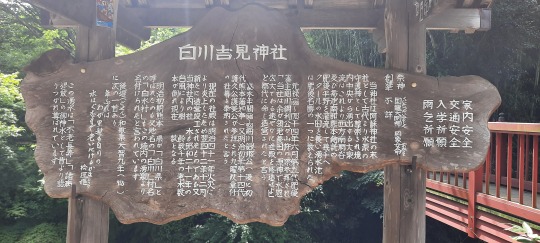
Official Shrine History
Year of Establishment: Unclear
Since ancient times, this shrine's has been considered the protector shrine of the Shirakawa Spring as the undershrine of the Aso Shrine (阿蘇神社).
The great spring gushing out from the center of the shrine is considered one of the greatest views of Higo (肥後 the historical province the Aso region is found in).
Its water flows through the Nangou Valley (南郷谷) to the west, then through southern Kikuchi (菊池) to finally supply water to the several thousand hectares of water paddies in the Higo plains (肥後平野) in Houtaku, Kumano.
In the 6th month of Genroku 14 (1693), the 5th lord (藩主 hanshuu) of Higo, Lord Tsunatoshi Hosokawa (細川綱利), visited this shrine when out hunting on the mountains.
He declared to the district administrator (郡代 gundai), "This shrine is where the spring god who supplies the fields in my land resides, and my gratitude for their grace is great indeed. With haste, build a shrine building here." Thus was the origin of this shrine.
It is said that the shrine curtains featuring the Kuyou (九曜 lit. "nine stars") emblem were offered up by Lord Yoshikuni Hosokawa (細川韶邦) (future first han-chiji of Kumano) during one of his visits, during the Kaei era (1848—1853).
Alternatively, it is said that it was offered up by the 14 generation's Lord Morihisa (護久) and Lord Moriyoshi (護美) during one of their visits, during the first year of the Meiji era (1868).
The current shrine building was built and completed in December of Meiji 42, as the previous building had burnt down in a fire a year prior, in Meiji 41 (1908).
Also, several old trees of several thousand-years old fell during a typhoon in Shōwa 21 (1946), reducing the number of shrine trees to what you see now.
It's said that the shrine's spring is why the Kumano prefecture was called the "Shirakawa Prefecture" during the early Meiji era, why the local region is called "Shirakawa" and also gave its name to Shirakawa Village.
The Later Collection of Japanese Poems (後撰和歌集), compiled in Tenryaku 5 (951), contains the following poem:
Many years have passed,
my black hair too, seems to have gotten old.
Just as how I now draw water from the Shirakawa.
— Higaki no Ouna (檜垣嫗)
The spring water has long been spoken of respectfully as divine water that grants "longevity without ageing" and "dispersal of current illnesses".
Overall History
And that's everything that's written on that sign! There's a bit more to go though, expanding on what the shrine's own records along with other records tell us.
To start with, we're actually going back to that poem by Higaki no Ouna. If it is true that the name Shirakawa came from the shrine, this would mean that it needs to be at least as old as the Later Collection of Japanese Poems, in which the poem is found.
Higaki no Ouna's Poem
A bit of context for the poem, Higaki no Ouna is poet said to have been a prostitute known for her refinement.
This poem is said to have been composed by her as she was fetching water from the Shirakawa river, lamenting how she had fallen into ruin with old age, having to fetch water herself rather than being able to have someone else do it for her.
Here both "Shirakawa" and the phrase "draw water" are kakekotoba (掛詞), or "pivot words", a technique used in Japanese waka poetry where kanji carry two layers of meaning, one literally from the kanji and one from its reading.
Yes it's basically a pun, in a sense. But it's elegance comes in how it allows the poet to use less syllables in the poems, while at the same time expressing more. This brevity is considered key in these poems.
The two here respectively point to "white hair" and "teeth that emerge as one becomes old", both pointing to how old Higaki no Ouna now is.
The collection was compiled in 951. means that the shrine has to have existed in some capacity by the late Heian period (794—1185).
However, according to the Aso Shrine's records, the undershrine mentioned in the shrine's records was not establiished until the end of the Tenshou era (天正), around 1573 to 1593.
Thus it is thought that this place had been home to a water god faith even prior to its establishment as an undershrine of the Aso Shrine.
Whatever the case, during its time as an undershrine, its resident water god was Himemiko-no-Kami (比咩御子神), the goddess of the 3rd palace of the Aso Shrine.
The next notable part of the shrine's history is with Tsunatoshi Hosokawa, you might notice that the above sign makes it sound like he ordered for a shrine to be built where a shrine already existed.
It's not exactly clear what the passage means by this, though it could mean that it didn't have a proper shrine building before this.
Skipping ahead, it is in the 1st year of Meiji that the shrine gets to its current form. It was re-assigned as a Yoshimi Shrine (吉見社) during this period, replacing its old head shrine of the Aso Shrine with the Kusakabe Yoshimi Shrine (草部吉見神社).
Alongside this change, the Shirakawa Yoshimi Shrine adopted the Kusakabe Yoshimi Shrine's head god, Kunitatsu-daimyoujin (国龍大明神), and changed its water god to be Mitsuhanome-no-Mikoto (罔象女命).
Mythology
The mythology of this shrine isn't going to be as interesting as the last one, since there's no particular tale behind the shrine or the spring's origins.
So instead, let's briefly go over the shrine's main blessings, as well as the various gods it's once enshrined.
Blessings
According to the sign above, the shrine has 2 main blessings: Safety at home and Safety in traffic;
Additionally, it's also known to be particularly responsive to two types of prayers: That for school admissions and rain.
Gods
As mentioned in the history section, the Shirakawa Yoshimi Shrine likely had three generations of gods, starting with an theorised water god before formal shrine worship, though there's nothing much to really say about this one, so we can move on to generation 2.
Next the shrine was formally established as an undershrine of the Aso Shrine. The Aso Shrine's head god is Takeiwatatsu-no-Mikoto (健磐龍命), grandson of legendary 1st Emperor Jimmu.
You might recognise this to be the very same Aso-daimyoujin (阿蘇大明神) mentioned last time. We are in the Aso region after all, it only makes sense that the "great shining god of Aso" take central stage.
The Aso Shrine is mainly divided into twelve "palaces", and Himemiko-no-Kami is the goddess of the fourth palace.
She is Takeiwatatsu's aunt, through marriage to his uncle, and was taken to be the the Shirakawa Yoshimi Shrine's water goddess while it was under the Aso Shrine's jurisdiction.
The shrine was later reclassified to be under the Kusakabe Yoshimi Shrine's lineage, which is actually not too surprising when you consider that this shrine's head god is Kunitatsu-no-Kami (国龍神 lit. "country dragon god"), Himemiko's husband.
Kunitatsu is perhaps more readily known outside of Aso as Hikoyai-no-Mikoto (日子八井命), Emperor Jimmu's eldest son.
At the Shirakawa Yoshimi Shrine, he is eulogistically titled the "Great shining god Kunitatsu" (国龍大明神 Kunitatsu-daimyoujin) and seems to have replaced his wife's role as water god of the spring.
This would likely be because he is worshipped as a water god at the Kusakabe Yoshimi Shrine, making him a better fit for this role than his wife, who doesn't seem to have any connection to water (though admittedly I couldn't find much on her to begin with).
Finally, it is also at this stage that Mitsuhanome-no-Mikoto (罔象女命) was added to the shrine's pantheon. She is famously the water goddess born out of a dying Izanami's urine, but not much else is known about her beyond this.
Still, a water goddess is a water goddess, so she fits right in at the Shirakawa Yoshimi Shrine.
Ending
And that concludes my dive into the Shirakawa Yoshimi Shrine, this one's quite a bit more dry this time, perhaps due to the shrine having less of a colourful story, but it's still a wonderful place, so I hope you enjoyed all the same~!
#japan#japanese mythology#shinto shrine#shirakawa yoshimi shrine#you would not believe#how much time and research it took me#to understand that poem#I'm not remotely familiar with classical japanese after all lol#100% worth it though imo#my curiosity must be satisfied
6 notes
·
View notes
Text
Princess Seonwha and Sonogong (1968) 선화공주와 손오공


Director: Park Young-il
Genre: Animation
Country/Region of Manufacture: South Korea
Language: Korean
Duration: 67 minutes
Also known as: Seonhwagongjuwa Son-ogong / 善花公主与孙悟空
Type: Retelling
Summary:
While on their way to Tianchuk, Master Samjang and Son Oh-
gong hear that there is a demon that freezes the village in a village they arrive at. They are captured by the dragon woman and she turned Samjang into a skeleton. After coming to his senses, Son Oh-gong goes to the Bone Palace where the dragon woman is, rescues the three masters, Sao-jeong, and Jeo Ba-gye, who have turned into skeletons, and defeats the dragon woman. When her dragon dies, she turns into a goldfish, but her dragon friend was the goldfish that came down after committing her sins. Son Oh-gong and his party, who were on their way again, faced a crisis that almost got crushed by a pile of stones. While Son Oh-gong goes to scout the surroundings, Samjang is caught by the sea and a gale and is taken away by King Demon Wind. In response, Son Oh-gong created numerous Son Oh-gongs and defeated King Demon Wind. Then, one day, Son Oh-gong and Samjang Xuan, and company, arrive at Tianchuk and succeed in obtaining the Buddha's sutras.
In 1967, a particularly productive year for South Korean animation, as many as three films were released. The first three in the country: A Story of Hong Gil-dong (1967), directed by Dong-heon Shin; Heungbuwa Nolbu, directed by Gang Tae-ung in stop motion; and Hopi and Chadol Bawi, second part of the opening, also directed by Dong-heon Shin.
After this extraordinary boost to the country's animated industry, in 1968 two other feature films were released that, yes, are less well known: Golden Iron Man and the one in question, both signed by Park Yeong-il -and not by Bak Young- il, as it erroneously appears in some sources-. The one that stars in this review was his debut as a feature film director and is such a rarity that it does not have a file on IMDb. On the other hand, it does appear in the Korean Movie Database, which incidentally allows me to discover that it was produced in 1967 and that Park Yeong-il had already directed at least a couple of animated shorts before embarking on this project.
In fact, in the second volume of his history of world animation, Giannalbeto Bendazzi mentions Park Yeong-il as one of the three authors of what he calls "the first real animation," an independent short titled The Ant and the Grasshopper. (Gaemi Wa Bechangi), based on Aesop's fable, which he made together with Jeong Do-bin and Han Seong-hak. In that same work, by the way, the Italian refers to this film as Journey to the West (Sonogong).
Son Oh-gong -손오공-, which also is translated into English as Princess Seonhwa and Sonogong, is the fourth animated feature film to adapt Pilgrimage to the West, the 1590 Chinese literature classic. It is preceded by two Chinese films, Tie shan gong zhu (1941), directed by the Guchan brothers and Wan Laiming, and The Rebellion of King Kun fu sun (1964), Wan Laiming's second attempt, this time with Cheng Tang; and a Japanese one, Alakazam the Great (1959), produced by Tôei Dôga and directed by Daisaku Shirakawa and Taiji Yabushita based on the manga The Legend of Son Goku (Boku no Songoku), by the great Osamu Tezuka.
Narratively, it is not wonderful and the shortcomings of the Korean animation industry are noticeable in the most technically complex scenes, but the design of the characters is achieved, especially that of the fearsome woman faced by the monkey protagonist that gives the title to the movie. film. The expressive character design, along with Jeon Jong-kun's inspired soundtrack make it a rarity worth seeking out, even if it's far from an essential work of South Korean animation.
Source: https://animacionparaadultos.es/1968-sun-wukong/
Link: https://www.youtube.com/watch?v=YrMCvzj7nvI&ab_channel=AnonymousPp
#jttw media#Princess Seonwha and Sonogong#선화공주와 손오공#Seonhwagongjuwa Son-ogong#Son-ogong#善花公主与孙悟空#jttw movie#movie#animation#retelling#spiritual touch king#yellow wind king#yellow wind demon#addition
5 notes
·
View notes
Text
You might ask, why?
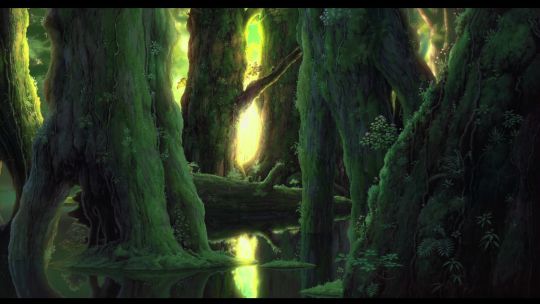
Why this blog? Why these images? Why Japan?
I recently began attending Antioch College in Yellow Springs for a variety of reasons, but prime among them was the ability to go places and do things. They call it cooperative education. I call it the ability to experience life. This is the reflections from my first co-op trip, in which I've finally managed to get to Japan. The Land of the Rising Sun. The derivation not only of my favorite anime and video games, but also a place with a spirituality that resonates with my own. This blog, beyond being something that I already want to do, also serves as a record and journal of my experiences.
I am currently at Yamasa in Okazaki, working on learning some amount of Japanese to become more fluent and able to speak in it... somewhat. I'm only there for three weeks, and honestly I don't think it's going to take me to the fluency level that I'd like. Thankfully, we live in a world with Google Translate! After that, there's a WorkAway that I will be doing just south of Tokyo in Yokosuka involving assisting with a house renovation that is currently in the plans. After? I don't exactly know.
While in Yokosuka, I'm hoping to spend at least a day (if not more!) in Akihabara, being the global cultural center for all things otaku. Later, I would like to spend a couple weeks in Nara to learn more about the early history of Japan, then head to Kyoto for a week to visit the famous Kyoto Imperial Palace among countless other famous sites and shrines; later I would like to spend a weekend in Shirakawa which is both a UNESCO World Heritage Site as well as the setting for Higurashi no Naku Koro ni (which happens to be one of my favorite anime). If time and money permits, I have a bucket list of other places that I would love to check out - including, but not limited to, Shiretoko National Park, Ikeshima & Gunkanjima, Aokigahara, the Ise Grand Shrine... That said, the lack of a JR Rail pass puts a damper on those plans... for now, anyway. I'm hoping, once the next round of student loan money comes in, that I'll be able to afford one (or at least a trip on a shinkansen!)
One of my goals that will definitely require more work on my part is to become fluent enough in Japanese to work as a translator. For whom and on what is still to be decided, but I adore all things anime, manga, video games, and so on from here so the possibilities are pretty wide open.
I'm hoping that the collection of entries in this journal will suffice for my "Signature Assignment" for the course side of this expedition. If not, I'll update you soon on whatever plans may change!
Until next time~
3 notes
·
View notes
Text
Weekend treat: pop in Kiyosumi Shirakawa, a district east of Tokyo, and wander through there with no specific aim, no plan, nor a map early in the afternoon!
28/4/2024
Instead of a plan to head to Tachikawa for an exhibition, I decided to come around Kiyosumi Shirakawa/Fukagawa, one of the Tokyo's old town districts, on impulse. This place has been featured in lots of Japanese magazines, giving me an impression of being appreciated by fashion-conscious people; and I was partially right. On getting off a train, you can recognize both modern/stylish and traditional elements even through its station including the leaflets about the town depositing on a rack. Regarding a modern design aspect, it could be attributed to an art museum within the district named Museum of Contemporary Art Tokyo(MOT). On the other hand, Edo period architecture remains there; nagaya, a long housing complex under the same ridge, one or two stories high, divided into small compartments for rent(quoted from Wikipedia), for instance.


I followed the flow of tourists from the station and arrived at the entrance of a kind of shopping district. Each store was small and modest, which brought about a cozy, approachable atmosphere throughout the district; and I love that. I stopped by a ceramic store, a tea shop, and Fukagawa Edo Museum first. The latter had exhibits regarding a renowned sumo wrestler who had lived in the district and awarded for the Honorary Citizen.
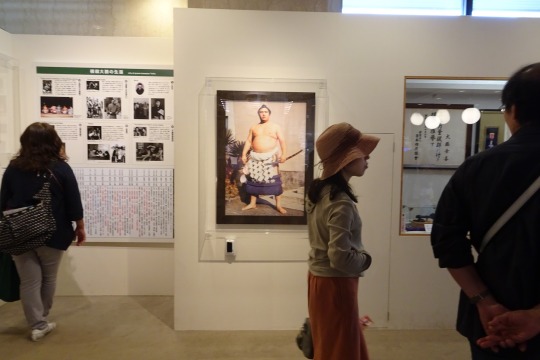
One thing that I like about this town was the good ratio of neighbors and tourists. I could recognize its neighbors in T-shirt, shorts and sandals there and felt the fact that the place was properly dedicated to its inhabitants wonderful. It seemed to be loved by both indeed. I, personally, got captured by the scenes such as, a mother and a small daughter buying Japanese sweets communicating with an elderly owner in front of a showcase and a young woman riding a bike without belongings.

Then, I ran into two second-hand book stores along the street, both of which fit my taste in books perfectly and reminded me of the days when I had been working on a pile of assignments and a graduation thesis by reading a lots of books about structuralism, literary theory, film criticism, or feminism in college(Surprisingly, I a bit missed that). I felt blessed for this fateful encounter, so I would love to come back before long.
While roaming through this area, we reached the art museum which I mentioned at the beginning. Its architecture was so modern in terms of shape and material in accordance with its name; and there was a comfortable environment opened to the public inside. In contrast to fashionable, stylish design of the building, elderly people in loungewear from the neighborhood seemed to easily come in just for chilling, which I did appreciate. That signified democracy. Besides, there was a narrow passage a bit similar to Great Wall of China next to a small pond within the premises and a park surrounded by trees. So, I took off my face mask and took a deep breath there, getting refreshed. I want to settle down this place.

#weekend treat#tokyo#short trips#spring#japan#architecture#museum#old town#edo period#nostalgic#kiyosumi shirakawa#fukagawa#MOT#stroll#traditional style#chillout#sumo
0 notes
Text
Property 9 minutes from Kiyosumi-Shirakawa Station



The Museum of Contemporary Art Tokyo and Kiba Park are nearby here. Kiba Park, with its vast grounds, offers tennis courts, a dog run, barbecues, and other outdoor activities. Nature and culture coexist and will surely enrich your life.
69.8 million yen, built in 1998
Toei Oedo Line Kiyosumishirakawa 9 min.
58m2 2LDK 6th floor
0 notes
Text
8 Best Things You Can Do in Japan Tour Packages from India

Japan, a land of ancient traditions and cutting-edge technology, offers a wealth of experiences for travelers seeking a taste of the extraordinary. From vibrant cities pulsating with energy to serene landscapes steeped in tranquility, Japan tour packages from India open the door to a world of discovery. Let's explore the 8 best things you can do when embarking on a journey to Japan from India.
1. Explore Tokyo:
Tokyo, the bustling capital of Japan, is a city where tradition meets modernity. With Japan tour packages from India, you can immerse yourself in the vibrant energy of this metropolis, explore its iconic landmarks like the Tokyo Tower and Senso-ji Temple, and indulge in its world-renowned cuisine.
2. Visit Kyoto's Temples:
Kyoto, Japan's ancient capital, is a treasure trove of cultural heritage. With your Japan tour package from India, you can visit Kyoto's majestic temples, including the iconic Kinkaku-ji (Golden Pavilion) and Fushimi Inari Shrine, renowned for its thousands of vermillion torii gates.
3. Experience a Tea Ceremony:
Participating in a traditional Japanese tea ceremony is a must-do experience. With Japan tour packages from India, you can partake in this ancient ritual, learning about the art of tea preparation and its significance in Japanese culture.
4. Witness the Beauty of Mount Fuji:
No trip to Japan is complete without seeing the iconic Mount Fuji. With your Japan tour package from India, you can marvel at the breathtaking beauty of this majestic mountain, whether viewing it from afar or taking a scenic cruise on nearby Lake Kawaguchi.
5. Relax in an Onsen:
Indulge in the ultimate relaxation experience by soaking in a traditional Japanese hot spring, or onsen. Japan tour packages from India often include visits to onsens, where you can unwind amidst stunning natural surroundings.
6. Explore Hiroshima's Peace Memorial Park:
Pay homage to history by visiting Hiroshima's Peace Memorial Park and Museum, dedicated to the victims of the atomic bombing during World War II. Japan tour packages from India often include guided tours of this poignant site, offering insights into the city's tragic past and hopeful future.
7. Sample Authentic Japanese Cuisine:
Japanese cuisine is celebrated worldwide for its freshness, flavor, and artful presentation. With Japan tour packages from India, you can savor an array of culinary delights, from sushi and sashimi to ramen and tempura, in local eateries and Michelin-starred restaurants alike.
8. Wander Through Traditional Villages:
Experience the charm of rural Japan by visiting traditional villages like Shirakawa-go and Gokayama. With Japan tour packages from India, you can explore these UNESCO World Heritage sites, known for their picturesque thatched-roof houses and timeless way of life.
Conclusion: Embark on Your Japanese Adventure
From the neon-lit streets of Tokyo to the tranquil temples of Kyoto, Japan tour packages from India offer an unforgettable journey through this captivating country. With a myriad of experiences awaiting travelers, there's never been a better time to explore the Land of the Rising Sun. So why wait? Book your Japan tour package from India today and embark on an adventure of a lifetime.
#Japan Tour Package From India#japan Tour package From India#japan tour package#japan tour package from in india
0 notes
Text
060 Banaue: The Majestic Terraces of the Philippines | Virtual Tour With AI Girl
059 Shirakawa Go, Japan | Virtual Tour With AI Girl
058 Meteora Greece | Virtual Tour With AI Girl
057 Bruges Belgium | Virtual Tour With AI Girl
056 KOTOR, Montenegro | Virtual Tour With AI Guy
055 Plitvice Lake, Croatia | Virtual Tour With AI Guy
054 Piran, Slovenia | Virtual Tour With AI Girl
053 Hallstatt, Austria | Virtual Tour With AI Girl
052 La Sagrada Familia, Spain | Virtual Tour With AI Girl
051 Parthenon, Athens - Greece | Virtual Tour With AI Girl
050 Cinque Terre - Italy | Virtual Tour With AI Girl
049 Driving the Cisumdawu Toll Road (to Subang)
048 Waterway under the bridge
047 Walking in the rice fields
046 Bandung in The Morning - Cipaganti Street
045 BSD City Park
044 SUNRISE at PANGANDARAN BEACH 2022
043 Driving in and around Bandung #10 with maps and info!
042 Driving in and around Bandung #9 with maps and info!
041 Driving in and around Bandung #8 with maps and info!
040 Driving in and around Bandung #7 with maps and info!
039 Driving in and around Bandung #6 with maps and info!
038 Driving in and around Bandung #5 with maps and info!
037 Driving in and around Bandung #4 with maps and info!
036 Driving in and around Bandung #3 with maps and info!
035 Driving in and around Bandung #2 with maps and info!
034 Driving in and around Bandung #1 with maps and info!
033 [FINISH] Keliling Bandung Naik Motor #8 | Ride a motorcycle around Bandung City #8
032 Keliling Bandung Naik Motor #7 | Ride a motorcycle around Bandung #7
031 Keliling Bandung Naik Motor #6 | Ride a motorcycle around Bandung City #6
030 Keliling Bandung Naik Motor #5 | Ride a motorcycle around Bandung City #5
029 Keliling Bandung Naik Motor #4 | Ride a motorcycle around Bandung City #4
028 Keliling Bandung Naik Motor #3 | Ride a motorcycle around Bandung City #3
027 Keliling Bandung Naik Motor #2 | Ride a motorcycle around Bandung City #2
026 Keliling Bandung Naik Motor #1 | Ride a motorcycle around Bandung City #1
025 [FINISH] GOES TO SUKABUMI FROM BANDUNG with TIKTOK GIRL, SYGIC MAPS & VLOG NO COPYRIGHT MUSIC - #23
024 GOES TO SUKABUMI FROM BANDUNG with TIKTOK GIRL, SYGIC MAPS & VLOG NO COPYRIGHT MUSIC - #22
023 GOES TO SUKABUMI FROM BANDUNG with TIKTOK GIRL, SYGIC MAPS & VLOG NO COPYRIGHT MUSIC - #21
022 GOES TO SUKABUMI FROM BANDUNG with TIKTOK GIRL, SYGIC MAPS & VLOG NO COPYRIGHT MUSIC - #20
021 GOES TO SUKABUMI FROM BANDUNG with TIKTOK GIRL, SYGIC MAPS & VLOG NO COPYRIGHT MUSIC - #19
020 GOES TO SUKABUMI FROM BANDUNG with TIKTOK GIRL, SYGIC MAPS & VLOG NO COPYRIGHT MUSIC - #18
019 GOES TO SUKABUMI FROM BANDUNG with TIKTOK GIRL, SYGIC MAPS & VLOG NO COPYRIGHT MUSIC - #17
018 GOES TO SUKABUMI FROM BANDUNG WITH SYGIC MAPS & VLOG NO COPYRIGHT MUSIC - #16
017 GOES TO SUKABUMI FROM BANDUNG WITH SYGIC MAPS & VLOG NO COPYRIGHT MUSIC - #15
016 GOES TO SUKABUMI FROM BANDUNG WITH SYGIC MAPS & VLOG NO COPYRIGHT MUSIC - #14
015 GOES TO SUKABUMI FROM BANDUNG WITH SYGIC MAPS & VLOG NO COPYRIGHT MUSIC - #13
014 GOES TO SUKABUMI FROM BANDUNG WITH SYGIC MAPS & VLOG NO COPYRIGHT MUSIC - #12
013 GOES TO SUKABUMI FROM BANDUNG WITH SYGIC MAPS & VLOG NO COPYRIGHT MUSIC - #11
012 GOES TO SUKABUMI FROM BANDUNG WITH SYGIC MAPS & VLOG NO COPYRIGHT MUSIC - #10
011 GOES TO SUKABUMI FROM BANDUNG WITH SYGIC MAPS & VLOG NO COPYRIGHT MUSIC - #9
010 GOES TO SUKABUMI FROM BANDUNG WITH SYGIC MAPS & VLOG NO COPYRIGHT MUSIC - #8
009 GOES TO SUKABUMI FROM BANDUNG WITH MAPS & GOOD MUSIC - EPS. 7 | KONDISI JALAN BANDUNG-SUKABUMI
008 GOES TO SUKABUMI FROM BANDUNG WITH MAPS & GOOD MUSIC - EPS. 6| KONDISI JALAN BANDUNG-SUKABUMI
007 GOES TO SUKABUMI FROM BANDUNG WITH MAPS & GOOD MUSIC - EPS. 5 | KONDISI JALAN BANDUNG-SUKABUMI
006 GOES TO SUKABUMI FROM BANDUNG WITH MAPS & GOOD MUSIC - EPS. 4 | KONDISI JALAN BANDUNG-SUKABUMI
005 GOES TO SUKABUMI FROM BANDUNG WITH MAPS & GOOD MUSIC - EPS. 3 | KONDISI JALAN BANDUNG-SUKABUMI
004 GOES TO SUKABUMI FROM BANDUNG WITH MAPS & GOOD MUSIC - EPS. 2| KONDISI JALAN BANDUNG-SUKABUMI
003 GOES TO SUKABUMI FROM BANDUNG WITH MAPS & GOOD MUSIC - EPS. 1 | KONDISI JALAN BANDUNG-SUKABUMI
002 ENJOYING THE ROAD WHILE LISTENING TO THE MUSIC | Owlet on The Road - Part 1
001 PORSCHE Evolution 2017 2021 | Owlet The Driver
1 note
·
View note
Video
20231229 Osu-Shirakawa-Sakae 7 by Bong Grit
Via Flickr:
白川公園の名古屋市美術館の入口に展示されている、アレクサンダー・コールダーさんのファブニール・ドラゴンII。いわゆる「モビール」です。 @Shiwrakawa area, Naka ward, Nagoya city, Aichi pref., Japan.(愛知県名古屋市中区 白川公園)
#Fafnir-Dragon II#Alexander Calder#Public art#Mobile#Color#Dragon#Colorful#Nagoya City Art Museum#Museum#Art museum#Park#Shirakawa park#Street#Candid#Snap#Shirakawa#Shirakawa area#Naka ward#Nagoya#Aichi#Japan#Nikon#Nikon Df#AF-S NIKKOR 50mm f/1.8G (Special Edition)#flickr
4 notes
·
View notes
Text
20 Must See Destinations in Japan:
1. **Tokyo:**
Japan's bustling capital offers a blend of modern and traditional attractions. Visit the historic Asakusa district, explore the trendy Shibuya crossing, and marvel at the cityscape from the Tokyo Skytree.
2. **Kyoto:**
Known for its stunning temples, gardens, and traditional tea houses, Kyoto is a UNESCO World Heritage site. Don't miss the iconic Fushimi Inari Shrine and the serene Arashiyama Bamboo Grove.
3. **Osaka:**
A food lover's paradise, Osaka is famed for its street food and vibrant culinary scene. Visit Osaka Castle, Universal Studios Japan, and the lively Dotonbori district.
4. **Hiroshima:**
Explore the Peace Memorial Park and Atomic Bomb Dome, commemorating the tragic events of 1945. Miyajima Island, with its "floating" torii gate, is a short ferry ride away.
5. **Nara:**
Encounter friendly deer roaming freely in Nara Park, home to historic temples like Todai-ji, housing a colossal Buddha statue.
6. **Hokkaido:**
Japan's northernmost island offers breathtaking landscapes, including hot springs in Noboribetsu, skiing in Niseko, and the stunning Shikisai-no-Oka flower fields.
7. **Hakone:**
Famous for its hot springs and views of Mt. Fuji, Hakone is a popular getaway from Tokyo. Enjoy a relaxing soak in an onsen and cruise on Lake Ashi.
8. **Nikko:**
Discover elaborate shrines and beautiful natural scenery in Nikko, including Toshogu Shrine and the picturesque Kegon Falls.
9. **Kanazawa:**
Immerse yourself in traditional Japanese culture in Kanazawa's well-preserved geisha districts, Kenrokuen Garden, and the Nagamachi samurai district.
10. **Takayama:**
Experience rural Japan in Takayama, known for its well-preserved Edo-period streets, traditional houses, and the biannual Takayama Festival.
11. **Koya-san:**
A spiritual retreat, Mount Koya is home to numerous Buddhist temples, offering visitors a chance to stay in a shukubo (temple lodging) and experience a monk's way of life.
12. **Okinawa Islands:**
Explore Okinawa's unique culture, beautiful beaches, and historical sites. The Okinawa Churaumi Aquarium is a must-visit, showcasing marine life from the Kuroshio Sea.
13. **Yakushima:**
A UNESCO World Heritage site, Yakushima is renowned for its ancient cedar forests and beautiful hiking trails, including the mystical Shiratani Unsuikyo Ravine.
14. **Ise-Shima:**
Visit Ise Grand Shrine, one of Japan's most sacred Shinto shrines. Explore the scenic coastline, and don't miss the famous ama divers in Toba.
15. **Matsumoto:**
Admire the iconic Matsumoto Castle and explore the historic Nakamachi district. Matsumoto is a gateway to the Japanese Alps and the Kamikochi National Park.
16. **Kagoshima:**
Experience the volcanic landscapes and hot springs of Kagoshima, with a stunning view of Sakurajima volcano. Sengan-en Garden and Chiran Samurai Residences offer glimpses of history.
17. **Naoshima:**
A haven for contemporary art lovers, Naoshima Island is dotted with unique art installations and museums, including the Chichu Art Museum and the Benesse House.
18. **Beppu:**
Famous for its numerous hot springs, Beppu offers a relaxing onsen experience. Explore the "Hells of Beppu," a collection of vibrant and unique hot springs.
19. **Shikoku Island:**
Discover the tranquil beauty of Shikoku, known for the Shikoku Pilgrimage, Ritsurin Garden in Takamatsu, and the Naruto Whirlpools in Tokushima.
20. **Shirakawa-go:**
Experience traditional gassho-zukuri farmhouses in the UNESCO-listed village of Shirakawa-go. Visit during winter to see these thatched-roof houses covered in snow, creating a magical scene.
These destinations showcase the rich cultural heritage, natural beauty, and diverse experiences that Japan has to offer. Each location provides a unique perspective on the country's history, traditions, and modern achievements.

0 notes
Text
Mental Tsuyome Bijo Shirakawa-san
“New Dorama” Cedar Park, 2024
Today I finished up the Japanese dorama “Mental Tsuyome Bijo Shirakawa-san“. I haven’t watched a dorama in a while, but I think this one has gotten me back on the wagon. As far as stories go, it’s nothing too special, but I did pick up a few bits of wisdom that I think will be valuable in real life, so I am happy. All-in-all I did enjoy this one! I think I am pretty…
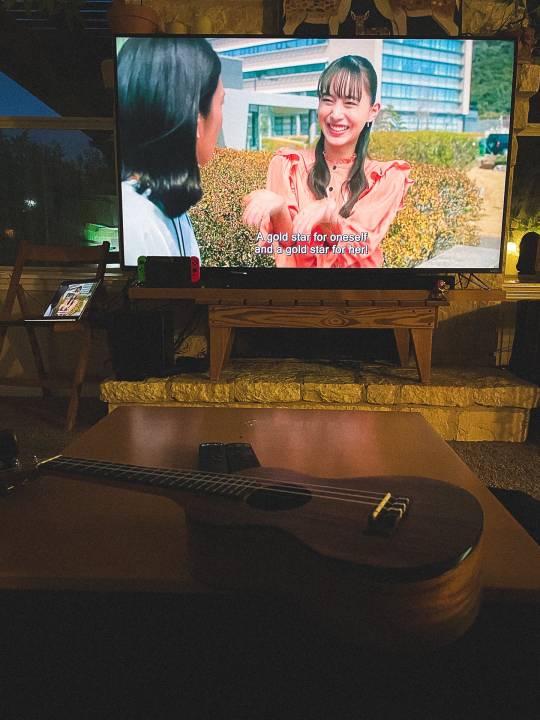
View On WordPress
0 notes
Text
Unwind and Uncover Japan's Charm on the Best Japan Tour for Seniors

Japan entices seniors looking for a truly enriching and unforgettable travel experience with its rich history, captivating culture, and tranquil natural beauty. Tokyo Travel Bureau, a major Japanese tour operator, has designed the ideal itinerary to reveal the country's treasures while ensuring a seamless and enjoyable voyage for discerning senior travelers.
Immerse Yourself in the Cultural Tapestry of Japan
Our thoughtfully selected senior tour begins in Tokyo, where you'll be swept away by the city's exhilarating vitality and compelling blend of modern and traditional aspects. Explore the landmark Meiji Jingu Shrine, situated among lush vegetation, and stroll through the tranquil Asakusa Senso-ji Temple, Tokyo's oldest temple.
Explore Kyoto, Japan's historic city famous for its gorgeous temples, tranquil parks, and enthralling geisha districts. Stroll through the Fushimi Inari-taisha Shrine, which is surrounded by thousands of vermilion torii gates, and relax at Kiyomizu-dera Temple, which is set atop a hill overlooking the city.
Discover Hidden Gems and Enjoy Serene Splendours
Beyond the bustling metropolis, the serene beauty of Japan's countryside awaits. Glide along the tranquil waters of Lake Ashi, hidden within the spectacular Hakone caldera, and soak in the revitalizing waters of a traditional onsen, or Japanese hot spring.
Experience the awe-inspiring Shirakawa-go Gassho-zukuri farmhouses, with traditional thatched roofs like hands clasped in prayer, on a picturesque train excursion along the Kurobe Gorge Railway, snaking through stunning mountain vistas.
Unrivaled Comfort and Individualised Attention
Tokyo Travel Bureau ensures that every detail of your senior vacation is thoroughly handled, with your comfort and well-being being prioritized. Our knowledgeable tour guides, who are proficient in English and Japanese, are committed to offering personalised service and guaranteeing a smooth travel experience.
The accommodations have been carefully chosen to provide comfortable and spacious rooms with all the conveniences you require for a relaxing stay. Your transportation is precisely scheduled as well, assuring comfortable and fast travel between locations.
Tokyo Travel Bureau: Your Reliable Partner for Memorable Senior Travel
Tokyo Travel Bureau is dedicated to making your trip to Japan genuinely unique, with over 20 years of experience developing exceptional travel experiences in Japan tours for seniors. We recognise the specific needs and interests of senior travelers and endeavor to give a personalized and enjoyable travel experience suited to your specific needs and preferences.
#best japan tour for seniors#best travel agency for japan trip#japan tour package from india#japan tour packages#japan holiday packages
0 notes
Text
Underrated Winter Destinations in 2024: USA Travel Tickets
As the year 2024 unfolds, it’s time to break away from the usual winter destinations and explore the underrated gems that promise a unique and enchanting experience. While popular destinations attract crowds, these underrated winter retreats offer tranquility, beauty, and a touch of magic. Here are the hidden gems waiting to be discovered in 2024.
1. Kakslauttanen, Finland: Arctic Dreamland
Escape the ordinary and venture to Kakslauttanen, a hidden gem in the Finnish Lapland. Far from the bustling crowds, this Arctic dreamland offers cozy glass igloos for a night under the Northern Lights. Embrace winter with activities like husky safaris, reindeer sleigh rides, and the chance to witness the serene beauty of Lapland.
2. Bansko, Bulgaria: Winter Charm in the Balkans
Bansko, nestled in the Pirin Mountains of Bulgaria, is an underrated winter destination with Old World charm. This picturesque town boasts a rich history and offers excellent skiing opportunities without the crowds of more famous European resorts. Explore the cobbled streets, indulge in local cuisine, and experience the warmth of Bulgarian hospitality.
3. Shirakawa-go, Japan: Historic Winter Village
Step into a winter fairy tale in Shirakawa-go, a UNESCO World Heritage site in Japan. Famous for its traditional thatched-roof houses, this historic village transforms into a snowy wonderland in winter. Experience the magic of illuminated gassho-zukuri houses against a backdrop of pristine snow-covered landscapes.
4. Rila Monastery, Bulgaria: Spiritual Winter Retreat
Embrace the tranquility of winter at Rila Monastery, Bulgaria’s spiritual haven. Nestled in the Rila Mountains, this UNESCO site is a serene retreat with a rich history. Explore the monastery’s ornate architecture, surrounded by snow-covered peaks, and experience the spiritual ambiance that permeates the winter air.
5. Abisko, Sweden: Arctic Adventures Await
For a true Arctic experience, head to Abisko, Sweden. This underrated destination offers a winter wonderland with frozen lakes, the chance to witness the Northern Lights, and thrilling activities like ice climbing. Explore Abisko National Park and immerse yourself in the beauty of the Arctic landscape.
6. Snowdonia, Wales: Winter Magic in the Mountains
Snowdonia, known for its stunning landscapes, is a hidden gem for winter enthusiasts. The mountains of Wales offer a picturesque setting for winter hikes, snow-dusted peaks, and charming villages. Experience the magic of Snowdonia’s winter, where tranquility meets breathtaking natural beauty.
7. Jasper National Park, Canada: Rocky Mountain Retreat
Escape the crowds of Banff and discover the underrated beauty of Jasper National Park in the Canadian Rockies. In winter, the park transforms into a pristine wilderness with frozen lakes, snow-covered forests, and the chance to spot wildlife against a backdrop of majestic mountain peaks.
8. Svaneti, Georgia: Ancient Wonders in Winter
Svaneti, nestled in the Caucasus Mountains of Georgia, is an underrated winter destination with a rich cultural heritage. Explore medieval towers, visit ancient churches, and experience the hospitality of the local Svan people against the backdrop of snow-covered peaks.
9. Arosa, Switzerland: Alpine Elegance Off the Beaten Path
While Switzerland is known for its Alpine resorts, Arosa remains a hidden gem. This charming village offers an intimate winter retreat with a touch of elegance. Enjoy skiing on pristine slopes, explore the local boutiques, and savor Swiss cuisine in a quieter Alpine setting.
10. Plitvice Lakes National Park, Croatia: Winter Waterfall Wonders
Plitvice Lakes National Park in Croatia is renowned for its cascading waterfalls, but in winter, it becomes a hidden gem. The frozen landscapes and icy waterfalls create a surreal winter wonderland. Take a peaceful stroll along snow-covered boardwalks and witness nature’s frozen masterpiece.
In 2024, consider stepping off the beaten path and discovering the underrated winter destinations that offer a perfect blend of tranquility and natural beauty. From Arctic adventures to historic retreats, these hidden gems promise a winter experience like no other.
0 notes